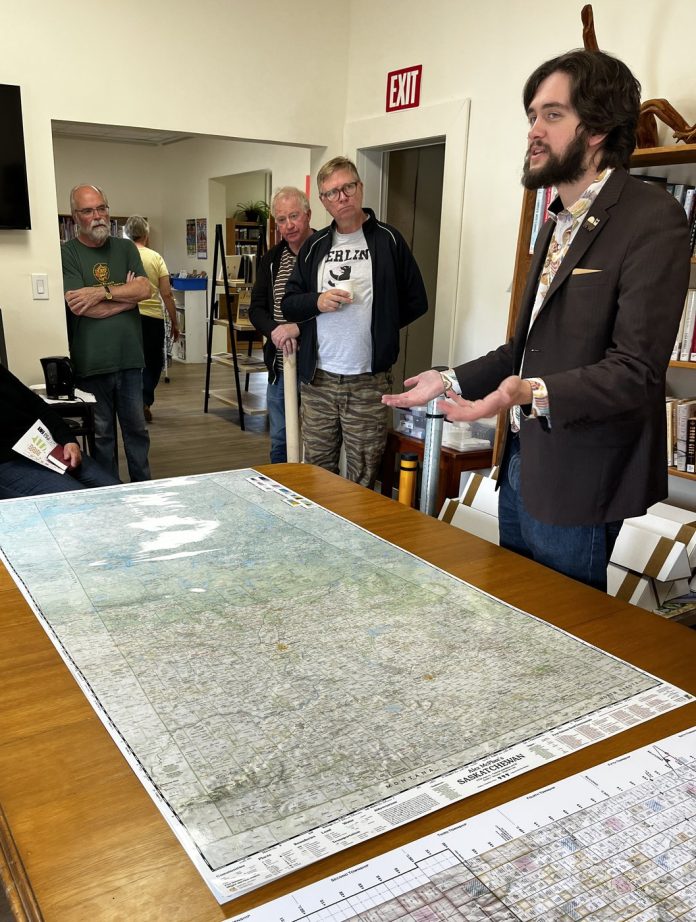
Wendy Thienes
Local Journalism Initiative Reporter
The Shaunavon Standard
Eastend Library and its oversized, antique meeting room table were filled to the brim on Sunday, September 15 as Alex McPhee, owner of Pronghorn Maps based in Val Marie, rolled into town and unrolled his 36” x 66” map of Saskatchewan for viewing and discussion. Following a dynamic and passionate presentation and answering questions from an engaged audience, the group moved to the map and continued to converse and pour over the many details of his mammoth project.
McPhee demonstrates advanced knowledge of history and of his chosen profession of cartography (map-making). At only 26 years of age, he has taken his University of Alberta education in geophysics and spun that with his passion for maps. His interest in maps began at the U of A campus library where he would frequent the map room (while avoiding a boring class, or two). He has drawn his love of history and maps together into a viable and growing entrepreneurial endeavour as a self-taught cartographer.
McPhee has become somewhat of a local celebrity known simply as “The Map Guy”. He says he won’t personalize his license plate to that any time soon, and is quite surprised at the unexpected personal status that his work has resulted in.
McPhee moved to Val Marie about four years ago and has become involved in both the heritage and artistic community. His first job as a teen was as a tourist guide at a grain elevator at a museum in Alberta, which sparked an interest in grain elevators and other disappearing structures on the prairies. That job has come full circle as he currently chairs the Val Marie Heritage Grain Elevator committee where he is once again tasked with providing tours of a grain elevator. His love of history also drives his passion for maps.
His unique and thorough Saskatchewan map includes historical grain elevator locations with data sourced from archived grain licensing books. There are symbols representing abandoned rail lines, previous National Parks, current wind farms, Treaty boundaries and other Indigenous geography including reserve surrenders and Metis settlements which are indicated with the recognizable Metis Nation infinity symbol. Specific immigrant communities of Black and Jewish settlements are noted. If you look closely, you will find abandoned mines, airstrips and PFRA pastures.
Features such as cemeteries, school districts/houses, churches, stores and post offices simply cannot all be included on this particular map. To that end, McPhee is open to commission work and has recently completed a map for the R.M. of Waverley near Glentworth which includes many of those additional features along with minor waterways such as creeks.
“The data on this type of map is often confirmed by a group of guys around the RM table as they reminisce and recall certain features and names,” he commented.
Another project received recent attention in The Toronto Star. His Toronto languages map utilized census data to show where clusters of immigration occur within the city. When people comment on the multiculturalism of a centre like Toronto, he is quick to remind them that Canada has been multicultural for more than a century.
Maps are created at the discretion of the mapmaker, and McPhee believes his work is ‘half science, half art’ and he has therefore been embraced by the community of Val Marie where history, science of the Grasslands and a vibrant artistic community all exist in harmony.
Cartography is not a regulated profession (as opposed to surveying) so maps become somewhat subjective based on evidence or density of data available to the cartographer. He also describes his work as a subtractive process where he must determine which details remain and which cannot feasibly be included. A cluster of resort communities around Regina Beach is a good example of how difficult it may be to include every detail. Stylistically, the map has a retro feel with a font and overall appearance that is timeless. Its 2nd edition incorporates colorful map insets reminiscent of classic atlases featuring population density, elevation and mean temperature among others.
His Saskatchewan map is available for purchase online via his website at pronghornmaps.com with a few copies currently available at the Grand Coteau Heritage & Cultural Centre in Shaunavon. The laminated version of the map sells for $79.99. Other projects have included a large-scale Alberta map and map drawings for a novel. In the future, he would like to create a large-scale map of Canada and continue other commissioned work.
He indicated that there is essentially an unearned social trust of mapmakers, explaining, “People generally trust that what they see on a map is true and accurate. Everyone thinks maps are made by wizards. But, I’m just a guy.”
To which one might reply, “No, you’re the Map Guy.”

